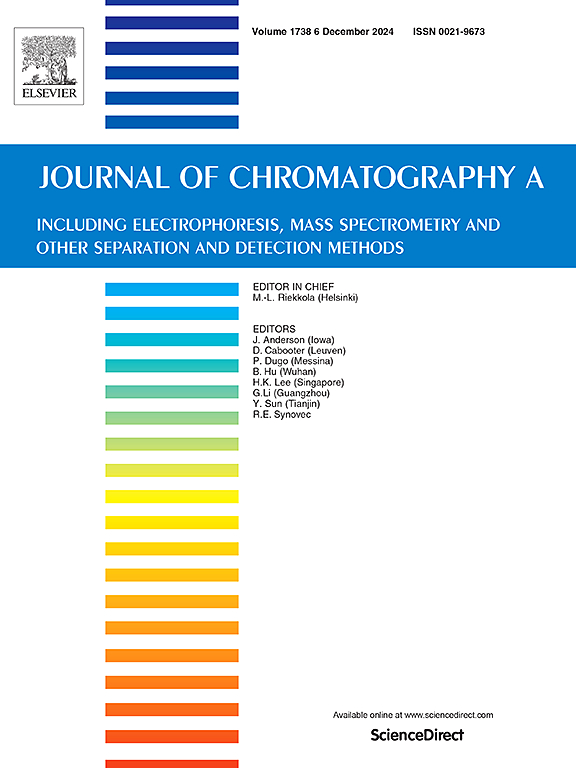An economically viable stable isotope-enhanced multiple reaction monitoring method for total fatty acid analysis in a mouse model of non-alcoholic fatty liver disease
IF 3.8
2区 化学
Q1 BIOCHEMICAL RESEARCH METHODS
引用次数: 0
Abstract
The complex pathological mechanisms of non-alcoholic fatty liver disease (NAFLD) are closely related to dysregulated lipid metabolism, and the therapeutic effects of the traditional Chinese medicine Zexie-Baizhu Decoction (AA) on NAFLD have been gaining increasing attention. However, research into altered lipid metabolism, especially fatty acids, in NAFLD and the intervention of AA faces technical challenges, especially in the precise quantitative analysis of fatty acids in biological samples. The high complexity of biological matrices, particularly after drug intervention, greatly increases the difficulty of detection. Therefore, this study innovatively developed a simple and economical stable isotope derivatization technique by synthesizing d6![]() N,N-dimethylethylenediamine (d6-DMED) in the laboratory, establishing a simple and economical method for fatty acid quantification. This method employs a chemical reaction under low-temperature conditions to ensure the efficient synthesis of d6-DMED. Using ultra-high performance liquid chromatography-triple quadrupole mass spectrometry technique (UHPLC-MS/MS), combined with optimized chromatographic separation conditions and dynamic multiple reaction monitoring mode, the study established a highly sensitive detection method for 35 fatty acid derivatives. Methodological evaluation showed that the limits of quantification ranged from 0.002 to 0.060 μM, with high linearity of R² > 0.995. Additionally, the relative recovery rates were between 93.14% and 106.63%. To further demonstrate the feasibility of this method for fatty acid quantification, it was applied to measure fatty acids in multiple tissues in a mouse NAFLD model, as well as the effects of AA intervention on fatty acid metabolism. This rapid, simple, and cost-effective detection method not only enhances the understanding of NAFLD mechanisms but also provides a new strategy for evaluating the biological complex system after drug intervention.
N,N-dimethylethylenediamine (d6-DMED) in the laboratory, establishing a simple and economical method for fatty acid quantification. This method employs a chemical reaction under low-temperature conditions to ensure the efficient synthesis of d6-DMED. Using ultra-high performance liquid chromatography-triple quadrupole mass spectrometry technique (UHPLC-MS/MS), combined with optimized chromatographic separation conditions and dynamic multiple reaction monitoring mode, the study established a highly sensitive detection method for 35 fatty acid derivatives. Methodological evaluation showed that the limits of quantification ranged from 0.002 to 0.060 μM, with high linearity of R² > 0.995. Additionally, the relative recovery rates were between 93.14% and 106.63%. To further demonstrate the feasibility of this method for fatty acid quantification, it was applied to measure fatty acids in multiple tissues in a mouse NAFLD model, as well as the effects of AA intervention on fatty acid metabolism. This rapid, simple, and cost-effective detection method not only enhances the understanding of NAFLD mechanisms but also provides a new strategy for evaluating the biological complex system after drug intervention.
一种经济可行的稳定同位素增强多反应监测方法,用于非酒精性脂肪肝小鼠模型的总脂肪酸分析。
非酒精性脂肪性肝病(NAFLD)的病理机制复杂,与脂质代谢紊乱密切相关,而中药泽泻白术汤(AA)对非酒精性脂肪性肝病的治疗效果日益受到关注。然而,非酒精性脂肪肝中脂质代谢(尤其是脂肪酸)的改变以及 AA 的干预研究面临着技术上的挑战,尤其是生物样本中脂肪酸的精确定量分析。生物基质的高度复杂性,尤其是药物干预后的生物基质,大大增加了检测的难度。因此,本研究通过在实验室合成 d6N,N-二甲基乙二胺(d6-DMED),创新性地发展了一种简单经济的稳定同位素衍生技术,建立了一种简单经济的脂肪酸定量分析方法。该方法采用低温条件下的化学反应,确保了 d6-DMED 的高效合成。该研究利用超高效液相色谱-三重四极杆质谱(UHPLC-MS/MS)技术,结合优化的色谱分离条件和动态多反应监测模式,建立了35种脂肪酸衍生物的高灵敏度检测方法。方法学评价表明,该方法的定量限为 0.002 至 0.060 μM,线性相关系数 R² > 0.995。此外,相对回收率在 93.14% 至 106.63% 之间。为了进一步证明该方法在脂肪酸定量方面的可行性,该方法被用于测量小鼠非酒精性脂肪肝模型中多个组织的脂肪酸含量,以及 AA 干预对脂肪酸代谢的影响。这种快速、简便、经济的检测方法不仅加深了人们对非酒精性脂肪肝机制的了解,而且为评估药物干预后的生物复杂系统提供了一种新策略。
本文章由计算机程序翻译,如有差异,请以英文原文为准。
求助全文
约1分钟内获得全文
求助全文
来源期刊

Journal of Chromatography A
化学-分析化学
CiteScore
7.90
自引率
14.60%
发文量
742
审稿时长
45 days
期刊介绍:
The Journal of Chromatography A provides a forum for the publication of original research and critical reviews on all aspects of fundamental and applied separation science. The scope of the journal includes chromatography and related techniques, electromigration techniques (e.g. electrophoresis, electrochromatography), hyphenated and other multi-dimensional techniques, sample preparation, and detection methods such as mass spectrometry. Contributions consist mainly of research papers dealing with the theory of separation methods, instrumental developments and analytical and preparative applications of general interest.
 求助内容:
求助内容: 应助结果提醒方式:
应助结果提醒方式:


